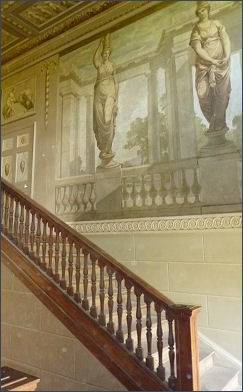Boconnoc House
OS Grid ref:-SX 147 607
 Boconnoc House near Lostwithiel is linked to one of the most famous jewels in history, the Pitt Diamond.
Boconnoc House near Lostwithiel is linked to one of the most famous jewels in history, the Pitt Diamond.
Boconnoc is mentioned in the Domesday book of 1086 where it is referred to as Bochenod. The first known owners were the De Cant family who lived there in 1268. The present house occupies the site of a medieval house owned successively by the Carminow and Mohun families.
 Lord Mohun's widow sold the estate to Governor Thomas 'Diamond' Pitt, a wealthy trader and Governor of Madras who had made a fortune in India. Pitt purchased the estate, along with much other property and land in Cornwall and elsewhere, with the proceeds of the sale of an extraordinary diamond, known as the Regent or Pitt diamond, to Prince Philippe II of France in 1717. He had acquired the diamond while Governor of Fort St. George, Madras. For a while, this gem adorned the hilt of Napoleon's sword, but it later found its way to the Louvre Museum where it has been on display since 1887, one of the Crown Jewels of France.
Lord Mohun's widow sold the estate to Governor Thomas 'Diamond' Pitt, a wealthy trader and Governor of Madras who had made a fortune in India. Pitt purchased the estate, along with much other property and land in Cornwall and elsewhere, with the proceeds of the sale of an extraordinary diamond, known as the Regent or Pitt diamond, to Prince Philippe II of France in 1717. He had acquired the diamond while Governor of Fort St. George, Madras. For a while, this gem adorned the hilt of Napoleon's sword, but it later found its way to the Louvre Museum where it has been on display since 1887, one of the Crown Jewels of France.
Pitt built the first wing of the house circa 1721. The second wing other was added in 1772 by Thomas Pitt, 1st Baron Camelford. The two wings formed an L-shape and the grounds are finely landscaped: on a hill behind the house is an obelisk in memory of Sir Richard Lyttelton (1771).
Thomas 'Diamond' Pitt founded a political dynasty that included numerous MPs, including his grandson William Pitt and great-grandson William Pitt the Younger. After Governor Thomas Pitt's death in 1726 the estate passed to his son Robert Pitt and then the following year to his son Thomas Pitt. On the death of the last male heir, Thomas, 2nd Lord Camelford, in 1804, the estate passed to his sister Lady Anne Grenville and thence to her nephew George Fortescue, great great grandfather of the current owner Anthony Fortescue .The Fortescue family who made some alterations to the structure in 1883. There are some more recent additions and the south wing was demolished in 1971.
The country estate is steeped in history including the story of how King Charles I once hid in one of the bedrooms during the Civil War. It includes the largest landscaped park in Cornwall. In 1993, the estate was used as a location for the film The Three Musketeers. The parish church is situated behind the house, it contains an interesting fifteenth century font and a monument to Penelope Mohun, dated 1637.
The estate, surrounding the River Lerryn, contains a deer park, lake and woodland. Parts of the estate are designated as Boconnoc Park Important Plant Area and Boconnoc Park & Woods Site of Special Scientific Interest.
Historic Buildings in Cornwall